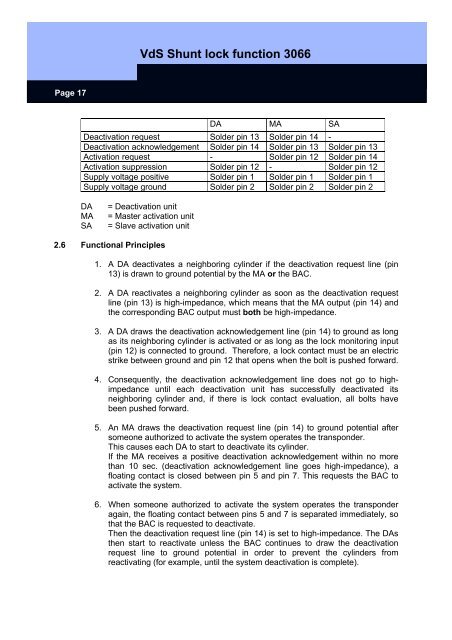LON ? Network 3065 - SimonsVoss technologies
LON ? Network 3065 - SimonsVoss technologies
LON ? Network 3065 - SimonsVoss technologies
Create successful ePaper yourself
Turn your PDF publications into a flip-book with our unique Google optimized e-Paper software.
Page 17<br />
VdS Shunt lock function 3066<br />
DA MA SA<br />
Deactivation request Solder pin 13 Solder pin 14 -<br />
Deactivation acknowledgement Solder pin 14 Solder pin 13 Solder pin 13<br />
Activation request - Solder pin 12 Solder pin 14<br />
Activation suppression Solder pin 12 - Solder pin 12<br />
Supply voltage positive Solder pin 1 Solder pin 1 Solder pin 1<br />
Supply voltage ground Solder pin 2 Solder pin 2 Solder pin 2<br />
DA = Deactivation unit<br />
MA = Master activation unit<br />
SA = Slave activation unit<br />
2.6 Functional Principles<br />
1. A DA deactivates a neighboring cylinder if the deactivation request line (pin<br />
13) is drawn to ground potential by the MA or the BAC.<br />
2. A DA reactivates a neighboring cylinder as soon as the deactivation request<br />
line (pin 13) is high-impedance, which means that the MA output (pin 14) and<br />
the corresponding BAC output must both be high-impedance.<br />
3. A DA draws the deactivation acknowledgement line (pin 14) to ground as long<br />
as its neighboring cylinder is activated or as long as the lock monitoring input<br />
(pin 12) is connected to ground. Therefore, a lock contact must be an electric<br />
strike between ground and pin 12 that opens when the bolt is pushed forward.<br />
4. Consequently, the deactivation acknowledgement line does not go to highimpedance<br />
until each deactivation unit has successfully deactivated its<br />
neighboring cylinder and, if there is lock contact evaluation, all bolts have<br />
been pushed forward.<br />
5. An MA draws the deactivation request line (pin 14) to ground potential after<br />
someone authorized to activate the system operates the transponder.<br />
This causes each DA to start to deactivate its cylinder.<br />
If the MA receives a positive deactivation acknowledgement within no more<br />
than 10 sec. (deactivation acknowledgement line goes high-impedance), a<br />
floating contact is closed between pin 5 and pin 7. This requests the BAC to<br />
activate the system.<br />
6. When someone authorized to activate the system operates the transponder<br />
again, the floating contact between pins 5 and 7 is separated immediately, so<br />
that the BAC is requested to deactivate.<br />
Then the deactivation request line (pin 14) is set to high-impedance. The DAs<br />
then start to reactivate unless the BAC continues to draw the deactivation<br />
request line to ground potential in order to prevent the cylinders from<br />
reactivating (for example, until the system deactivation is complete).
















